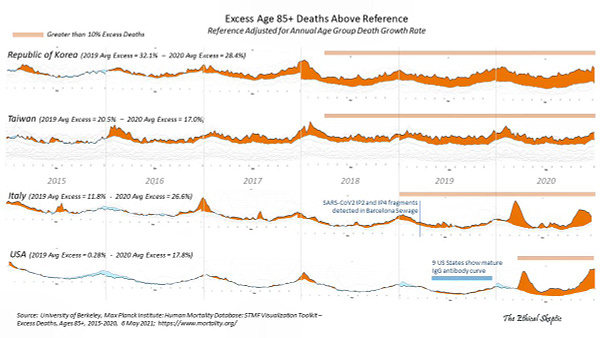The Earlier Lab Leak Hypothesis
The Earlier Lab Leak Hypothesis
The Chloroquine Wars Part LXXXI
"A blind investigation is the buffer of a bad democracy." -Mantaranjot Mangat
The "plandemic" conspiracy theorists point to Event 201 often. Of course, the players taking part in the event are controversial on many fronts.
But doubters and "fact checkers" tell us (over and over) that an event that took place on October 18, 2019 could not have been a preparation for the pandemic because there was no knowledge of the virus. Any sense of propaganda flooding the zone must be coincidental paranoia.
I've scratched my head over this for a while. Perhaps SARS-CoV-2 has been with us for longer than we knew? There are theories, and there is data...


What All Happened in October, 2019?
Was the shut down of Fort Detrick in 2019 purely a coincidence? Skeptics have wondered.
Why did China purchase PCR kits in bulk in May, 2019?
What was behind excess deaths in the Pacific Rim from late 2018 through 2019?


There have long been questions about SARS-CoV-2 specimens found on multiple continents prior to the official outbreak timeline. In particular, traces were found in waste water in Barcelona, Spain from a March 12, 2019 sample. Brazilian sewage samples showed SARS-CoV-2 from November, 2019 (Fongaro et al, 2021). Are these mistakes, or tainted samples, or was SARS-CoV-2 already circulating throughout 2019? A recently published genetic analysis (Bloom, 2021) of SARS-CoV-2 samples seems consistent with a wider phylogenetic tree than we might expect, and points to deletions of sequences in genetic databases that could cover those tracks.





And really, why would a lab leak in 2018 by any less likely than a lab leak in 2019? We know that coronavirus lab leaks have happened multiple times in China in the past. Could the Fall, 2019 lab leak story be the fallback story for a zoonotic outbreak story that never made sense?

On January 13, 2020, hydroxychloroquine, the zinc ionophore expected by many to be the most obvious first attempt off the shelf to tackle the next serious coronavirus outbreak, was added to the List II of poisonous substances in France. Effectively, this meant that the drug which was available over-the-counter for decades there, was only available through the medical bureaucracy. The Minister of Health that made the decision was Agnes Buzyn, who was often criticized over decisions that seemed in conflict of interest with respect to actions taken by her husband (with respect to vaccines in particular) Ives Levy, the CEO of INSERM who ushered in the Wuhan Institute of Virology in 2015. As French citizens cried "foul", the fact checkers pointed out that the decision to take HCQ away from OTC purchases was made on October 8, 2019, so it could not have been made with respect to the pandemic.
That of course assumes that there was no knowledge of the SARS-CoV-2 outbreak in early October of 2019. But if there was, we might assume a man in Levy's position would be among the first to know about it, or even the first to be aware of a plan on how to manipulate a challenging situation to the advantage of an international circle of vaccine manufacturers.
What's Up With Moderna, Anyhow?
Back in June, it was reported that potential coronavirus vaccine candidates were transferred from Moderna to the University of North Carolina in 2019, signed for by Ralph Baric "nineteen days prior to the official emergence of the COVID-19 pandemic." It has been pointed out that Moderna spent several years failing to yield results to justify its valuation. However, the Gates Foundation, which had previously invested $20M in Moderna (January, 2016), purchases $55M worth of BioNTech stock in September, 2019, though we're told that had nothing to do with coronavirus or anything like that, at all.
It's not surprising that the Bill & Melinda Gates Foundation also owns shares of BioNTech. Again, though, the nonprofit foundation didn't invest in the German biotech stock because of its coronavirus program.
The Gates Foundation first bought a position in BioNTech in September 2019, well before the COVID-19 pandemic hit. It invested $55 million in the biotech, with the potential for total funding to reach $100 million. The foundation's goal with this investment was to work with BioNTech to develop vaccines and immunotherapies for preventing HIV and tuberculosis (TB) infection.
As Whitney Webb notes in her thorough piece on Moderna, the Universal Flu Vaccine event that occurred in October, 2019 included an extremely creepy discussion of the need for a "disruptive scenario necessary to alter the public's perceptions of what a vaccine is and eliminate existing safeguards and bureaucracy in vaccine approval."
Earlier this week, an insider sent me several communications with disturbing implications.
Note that GMP means "good manufacturing practices" and indicates expenses taken for the production of biologics designated for humans, not lab animals or petri dishes.
The part about mRNA being "injected directly into the bloodstream" is troubling for obvious reasons. Isn't that something we're supposed to be trying to avoid?
Evidence that planning over the epidemic took place continues to mount, as do the implications.


Comments
Post a Comment